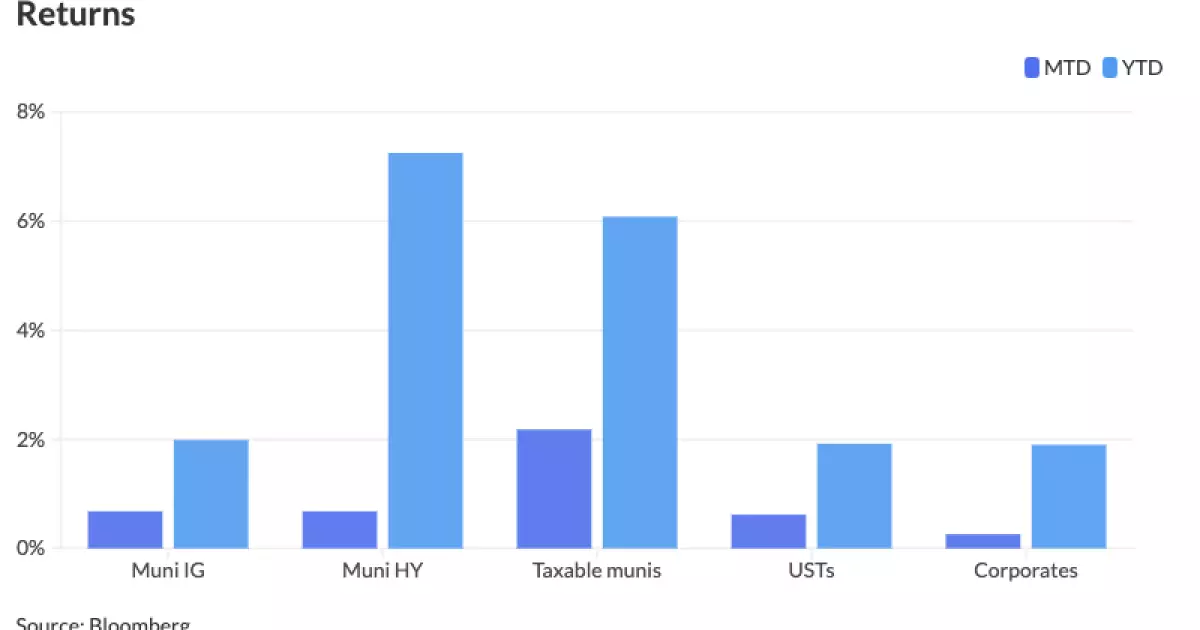The Current State of the Municipal Bond Market: Trends, Challenges, and Outlook

As we dive into the health of the municipal bond market, the dynamics present intriguing developments that are reflective of broader economic conditions. Recently, municipalities have managed to remain relatively steady, even encountering slight firming in specific areas. In contrast, U.S. Treasury yields displayed a decline, while equities presented a mixed bag toward the end of the trading session. Specifically, triple-A benchmarks noted minor improvements of up to three basis points across different points on the yield curve, coinciding with the U.S. Treasury yields, which fell by as much as five basis points, marking year-to-date lows.
This duality of performance — where municipal bonds have not kept pace with rallying U.S. Treasuries — is worth noting. As outlined in a recent report by Birch Creek strategic analysts, the municipal market underperformed for the second consecutive week, influenced by a significant new-issue calendar nearing $14 billion, which has diverted market attention. Such market behavior underscores the complexities and evolving nature of investor sentiment and strategy within municipal finance.
Recent Trends in Municipal Performance
Despite the noted underperformance against Treasuries, it is essential to examine the underlying trends affecting the municipal bond asset class. Throughout September, municipals have seen a modest yet positive return of 0.68% thus far, with an annual total return at 1.99%. This uptick in performance marks the highest total return observed since October of the previous year. Jason Wong, a municipal finance vice president at AmeriVet Securities, highlights that this uptick is associated with anticipated monetary policy adjustments.
With Federal Reserve expectations leaning toward potential rate cuts in the upcoming September meeting, Wong suggests that municipals may continue this upward momentum throughout the month. However, he also remarks on the dissonance in yield attractiveness compared to Treasuries, suggesting that although yields remain appealing, the comparative expense of municipal bonds could deter some investors. This perception is further substantiated by the ratios between municipal bonds and Treasuries, which show municipalities maintaining a higher yield ratio across various tenors, indicating nuanced investor behavior.
Fluctuating investor sentiment can significantly sway market direction. Observations suggest that fund flows have remained robust, reflecting the appetite for municipal bonds. Recently, investors have channeled an impressive $1.258 billion into municipal mutual funds, marking the eleventh consecutive week of inflows — an encouraging signal for market resilience. This inflow figure is particularly notable as it stands as the second-largest recorded for the year, providing necessary liquidity in the market.
Interestingly, this influx of capital has contributed to the competitive nature of new issue placements, where many recent offerings have experienced oversubscriptions. Analysts from Birch Creek indicate that the robustness of this new issue activity is helping to maintain market stability. Moreover, as many market players, including issuers, have anticipated the Fed’s policy alterations for several months, there are indications that some are opting to delay their borrowing plans pending outcomes from the Federal Open Market Committee’s decision. The strategic timing of such issuances raises critical questions about market timing and investor strategy.
Looking forward into the issuance calendar, we anticipate a notable surge in new municipal bonds being brought to market. While the upcoming week may showcase a slight dip in new issue volume compared to average activity, it is expected to rebound with several substantial offerings. Noteworthy upcoming deals include over $1 billion in bonds from Texas, Los Angeles, and New York’s Port Authority — a clear sign that municipalities continue to proactively manage their financing needs amid an evolving economic landscape.
This wave of large issuances serves as a critical juncture for municipal finance, as these offerings are poised to address essential projects and infrastructural developments. As we progress, the collective outcomes of these market factors — investor sentiment, economic indicators, and Fed policy decisions — will undoubtedly paint a clearer picture of both short-term and long-term municipal bond market trends.
While the municipal bond market presents signs of resilience and potential opportunities for growth, its future remains intertwined with broader economic movements and monetary policy adjustments. Investors and market participants must navigate these waters with a strategic mindset, weighing the allure of yields against market pricing fluctuations. As the Federal Reserve approaches its upcoming rate decision, all eyes will remain on these developments, signaling the next chapter in municipal finance. As such, the ability to respond to these evolving circumstances will define success within this crucial sector of the financial landscape.





